
Koi fish is famous among aquarists due to its remarkable look and vibrant colours. All koi varieties are the combination of different colours, patterns, elegance and traditions. Few of them have a stunning spectrum like black, white, orange and blue with metallic shine.
In the beginning, people use koi as a food source instead of decoration but after few years, koi become the symbols of positivity, peace and friendship in Japan and China. Chinese and Japanese called it “living jewels” because of its rich cultural heritage.
Its beautiful and stunning appearance with intricate patterns and hues makes ponds and aquariums more valuable and appealing. They are friendly in nature and have a longer lifespan, so koi keepers can develop their strong bond with them. They are able to recognize their owner.
In this article, you will get to know more about koi varieties, their pattern, care guide and recommendation, feeding schedule, water quality, filtration system along with maintenance instructions. Moreover, by reading this guide, you will be able to turn your pond into a colourful and flourishing environment.
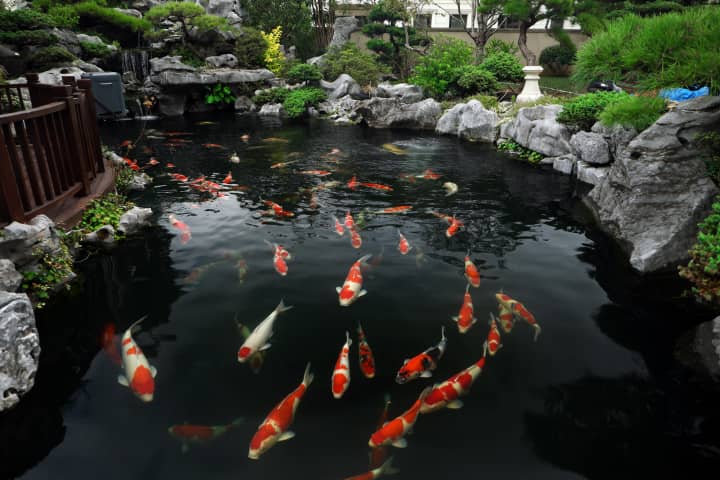
The world of koi fish has a wide range that is entirely different from one another to add a charm in the aquatic realm. Here , we will know about 12 essential types of koi fish.
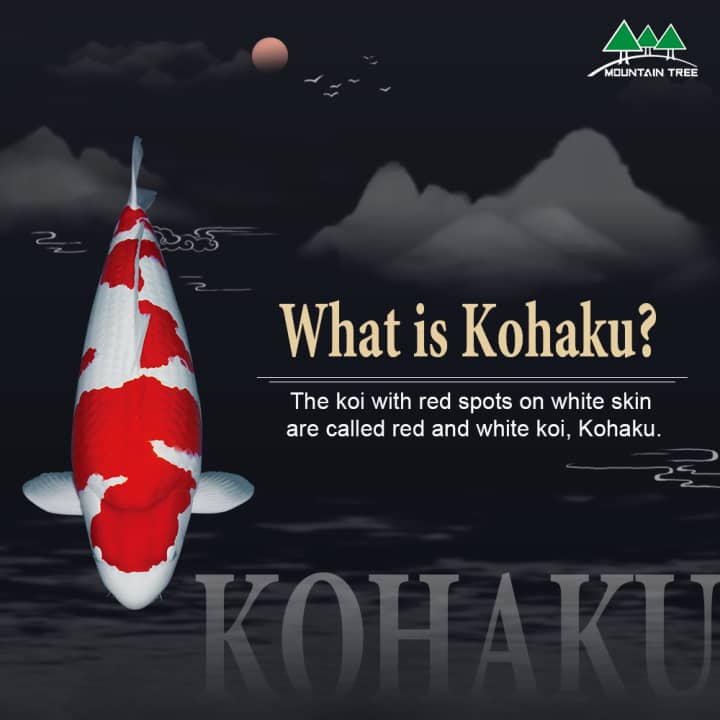
Kohaku is one of the well-known types of koi. It has a combination of white “shiroji” and red “hi”, their colour pattern makes them a well-balanced appearance and more attractive in clean water. Usually, red pigment on the scales of classic kohaku koi called “Kiwa” produces a striking contrast.
To choose the high-quality kohaku, hobbyists should consider the bright, snowy colour, free from discoloration, blotches and fading. Additionally, fish should also have fine lines, a healthy frame and be in good physical condition.
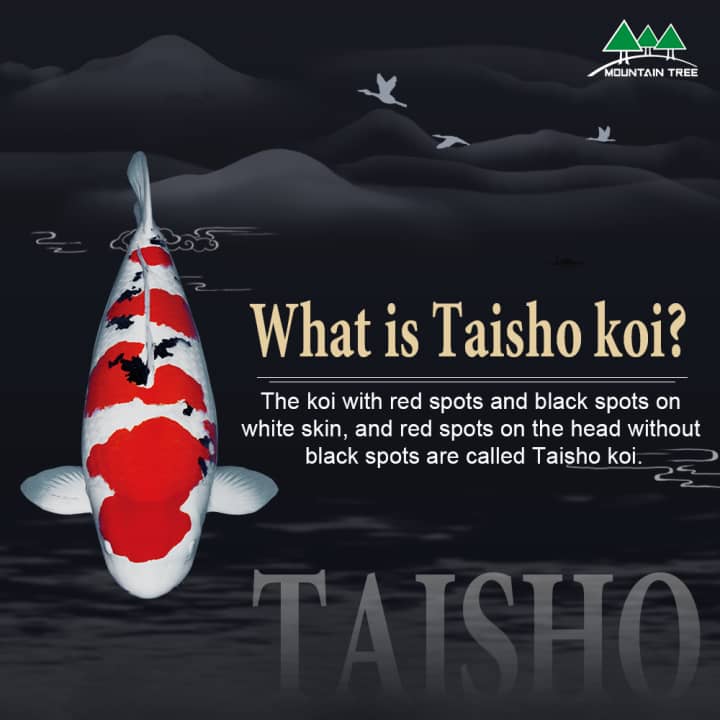
Taisho sanke also called as sanke. It is well known for three distinctive colour patterns (triocolor pattern). This koi has a wonderful white coloured body with red marking and black striking. Colours are evenly distributed on the body, red “hi” are more prominent than black “somi”.Black is not visible on the head, but it shows their patches throughout the contrast.
Sanke spawn in early summer and spring. Spawning process begins, when male follow the female koi,swimming up behind her and constantly pushing her. When male release sperm in water, eggs become fertilised and begin to develop.The value of sanke koi increases, due to the vivid colours and unique marking pattern. Expert breeders know the worth of taisho sanke and are ready to invest to buy and raise them to their profit.
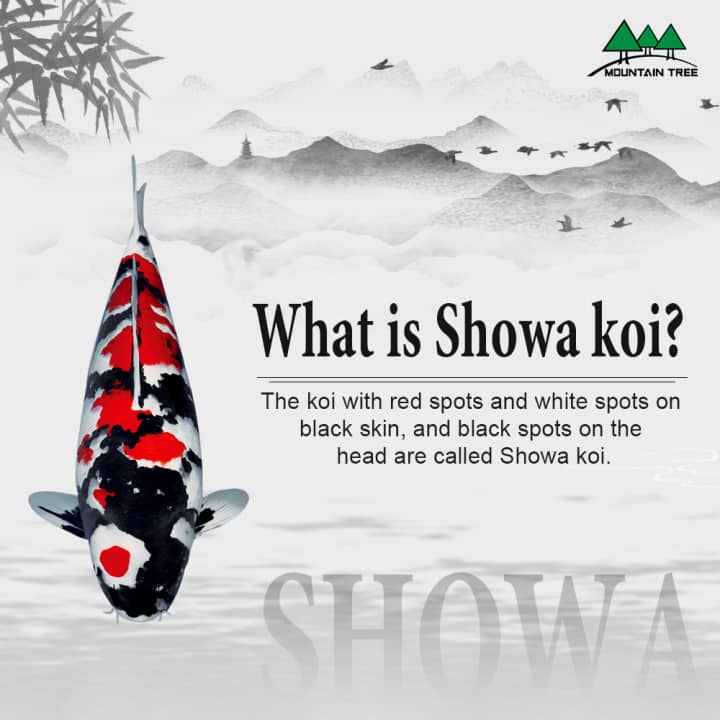
Showa’s eye-catching and dramatic pattern sets it apart from other koi species.the beautiful white and black coloured strips cover the black base of the body. Understanding the showa pattern needs to recognize the pattern of its three colours.
To maintain the brightness of colours, it is recommended to give them nutrient rich diets such as spirulina and carotenoids. High quality water, stable water parameters and calm environments, optimal care, also help to enhance the coloration of fish. Moreover, regular water changes are also important because poor water can reduce the vibrancy of body colour
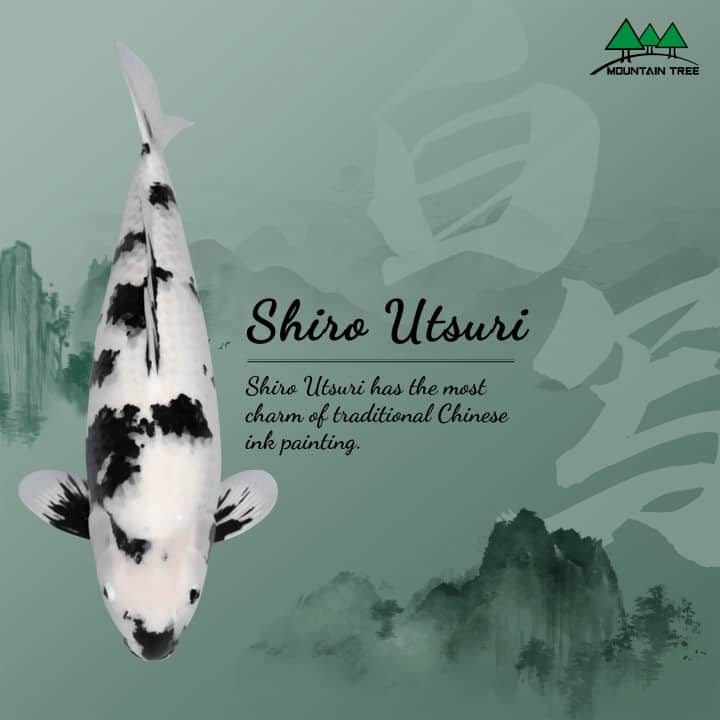
The name “Shiro Utsuri ” means black and white, which is perfectly suited with its unique appearance.its black and white body pattern is the result of mutation in the pigment producing cells. Both shades are well-distributed on the overall body, on the clean and crisp edges, white and black colour appear in a merged form.
For the optimal health and growth conditions, it is essential to maintain the high-quality water with effective filtration. Furthermore, utsuri requires a stress free environment, nutrient rich diet and special mineral supplies, to improve the overall growth.
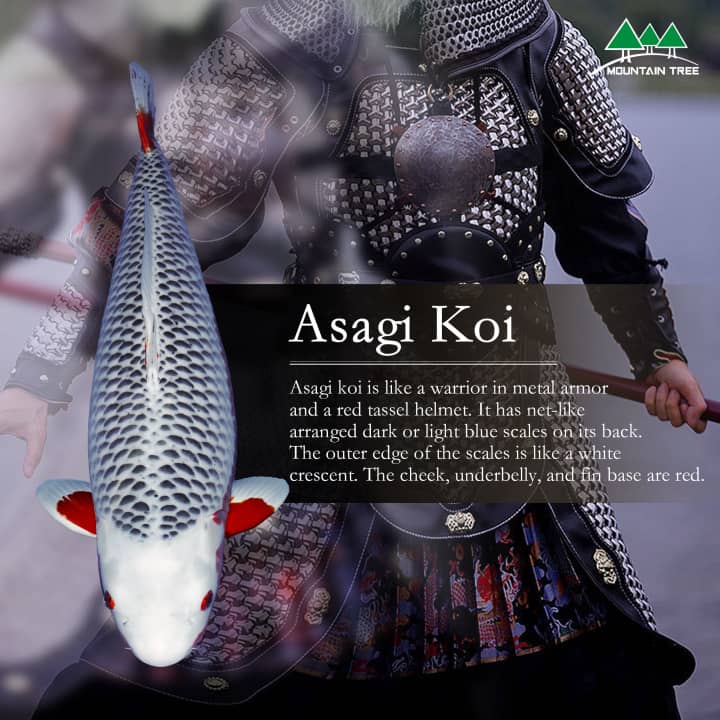
Asagi is a popular species and renowned for their distinct appearance. This fish is characterised by two primary features: its pectoral fin, which has a striking pattern of orange and red colours to enhance the beauty and another one is pale blue coloured net-like reticulated pattern to indigo scales in its back.
Improving the blue sheen asagi requires careful attention to nutrition and the surrounding environment. Their diet must be based on the formulated feed with colour-booster nutrients to intensify the body’s colour.
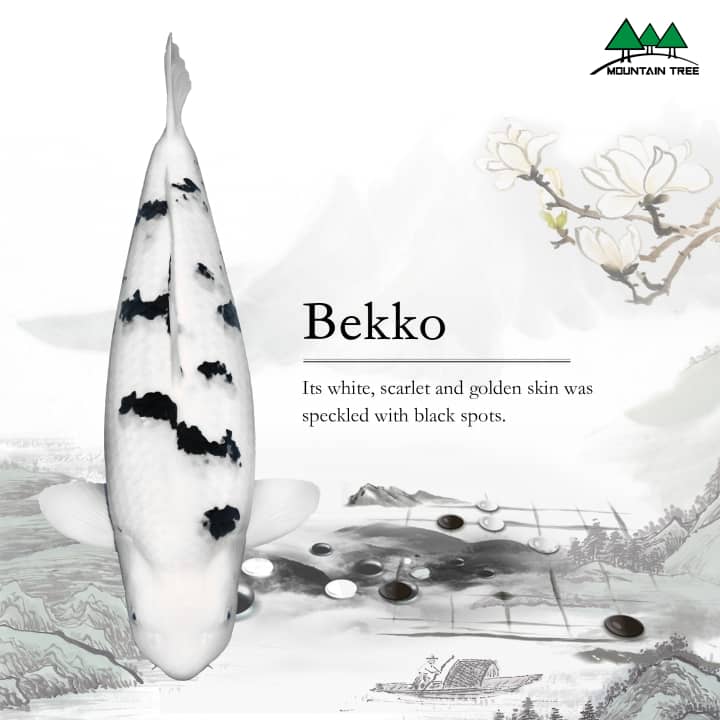
The Bekko koi type is known for its exquisite design. It is commonly available in white base colour with black spots, but it can be produced in red (Aka Bekko). A sequence of black spots, or sumi, are dispersed across the body of these fish. The pattern is evenly distributed with sharp and clean edges that improve the visual appearance of bekko.
When choosing an age-defining Bekko, pay attention to the colours and patterns of the Bekko koi.A superior Bekko will have a strong base colour that is brilliant and discoloration-free throughout life. Younger Bekko has lighter and less defined colours in the early stage of life. They will get sharper and darker with age. A mature Bekko has a healthy, sturdy, and symmetrical body frame with dark coloration.
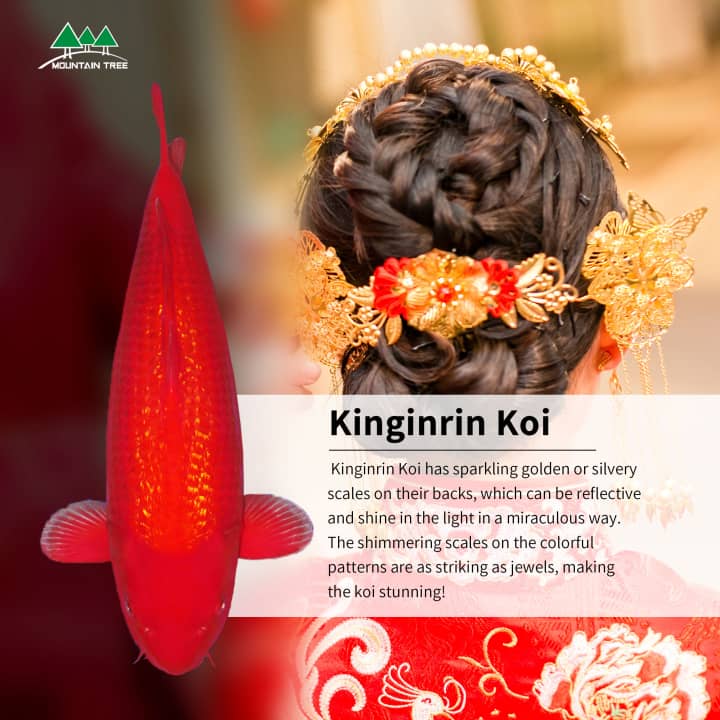
The koi variation Kin Gin Rin is called the “Golden Wonder” because of its well-known reflective and shimmery scales. These scales reflect light and produce a captivating sparkle across the fish’s body. The basic coloration and patterns are also enhanced with these remarkable scales.
Kin Gin Rin koi is uncommon due to its careful breeding, preservation, and unique appearance. The market demand for that variety is comparatively high, and enthusiasts are willing to invest in this rare koi variety to get more production and profit.
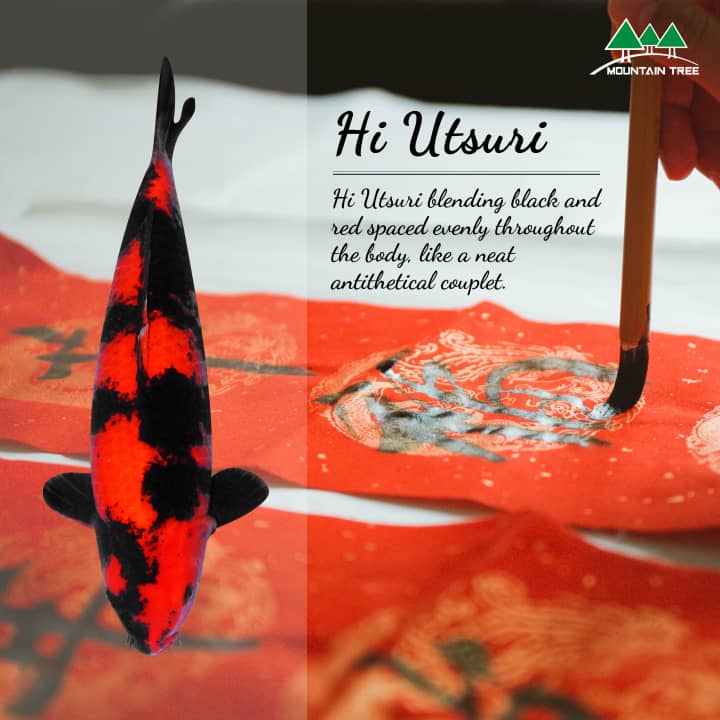
Hi Utsuri koi fish have black colour with striking red markings on their head, fins and body. This koi variety is the member of utsurimono, which also has three other koi varieties that are set apart by fascinating colours. Hi Utsuri is more captivating because of its striking red(hi) base with deep black (sumi) pattern; these patterns create beautiful contrast while retaining the clarity and richness of each colour.
The demand for Hi utsuri koi has risen dramatically in the last few years. Their amazing beauty and difficulty of achieving such a distinct contrast have made them more expensive and valuable in the market.
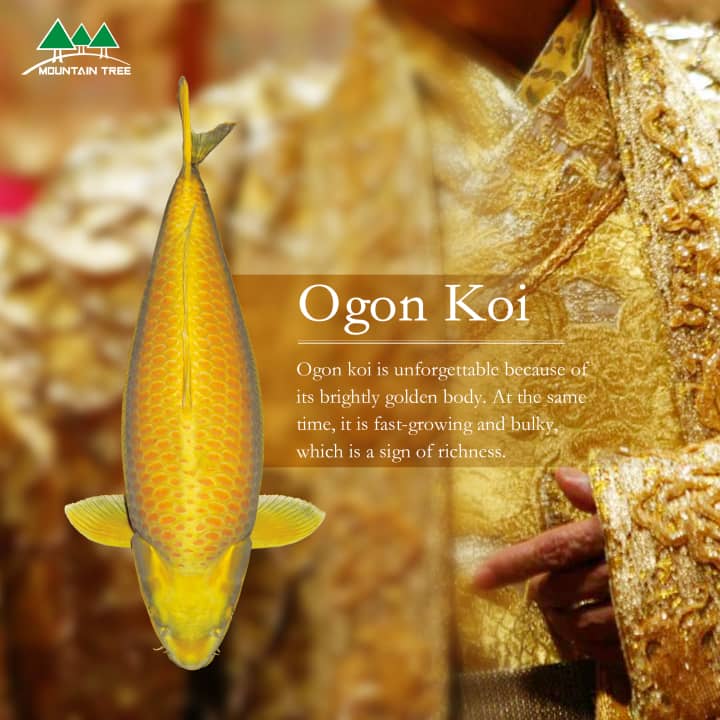
The ogon has a single coloured, shimmering metallic scale that can reflect the light and produce shine so, it is also known as “Metallic Majesty”. There are three types of ogon: shiny, gold coloured Yamabuki Ogon, the metallic and bright orange Mizuho Ogon, and the silvery-white Platinum Ogon.
The maintenance of the metallic scales of Ogon requires regular water change and proper filtration. Hight quality balanced nutrition like spirulina and carotenoids helps to improve their vibrant metallic sheen Additionally, another key of its brightness is ample space for movement and a less crowded pond.
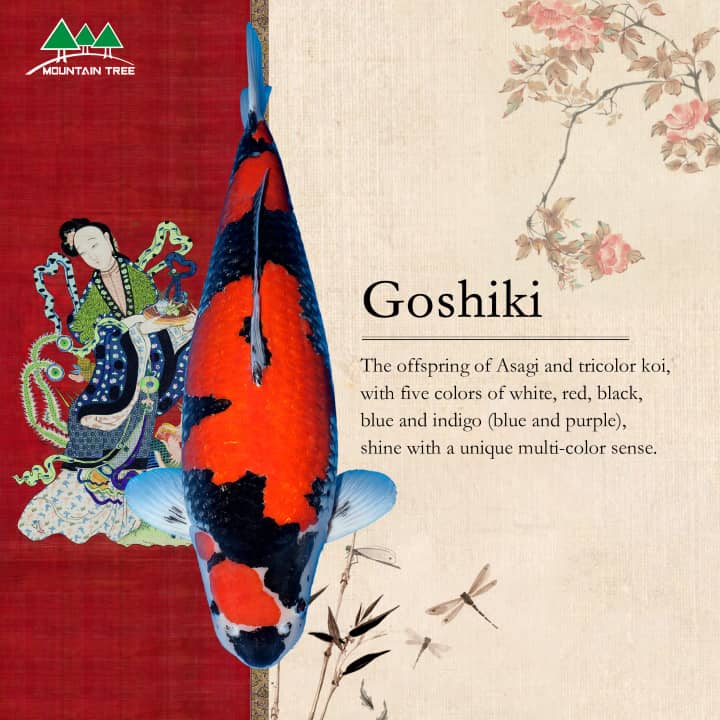
Goshiki, also called the “Five-Coloured Delights,” are a distinctive and striking type of koi that are popular for their complex, multi-layered colouring. The dramatic patterns of red, white, and occasionally yellow and silver are superimposed on a base of deep, reticulated blue or black. This overlapping creates a captivating combination of five colours.
Regular water monitoring, proper wiping of the debris from the water, a peaceful atmosphere, and high-quality feed are also important factors for the ideal growth of Goshiki.
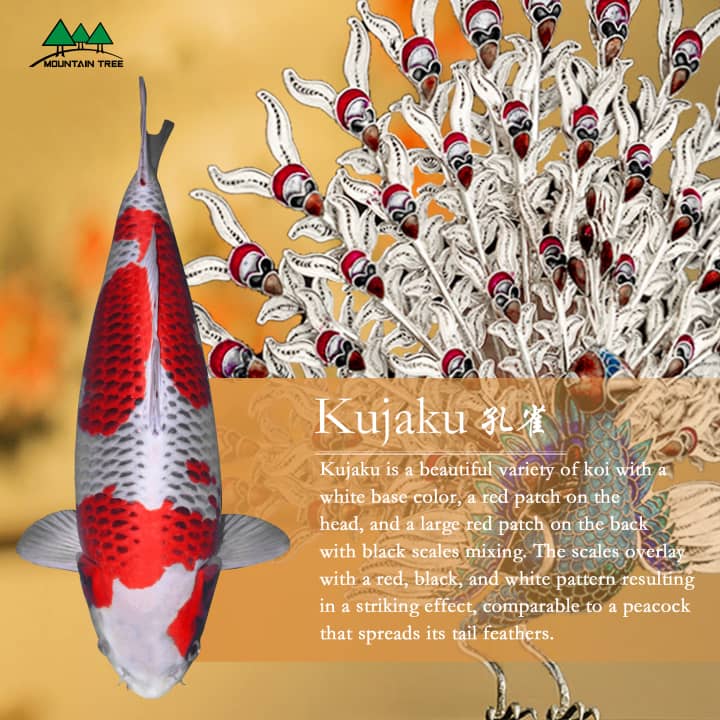
The Kujaku is renewed for its stunning and shimmering colours. It’s a gorgeous combination of bright red, orange, or yellow patterns on a shiny white or platinum foundation” with white base color and a larger red patch on the back with back scales mixing. Hues are layered with a reticulated black netting design that resembles the delicate feathers of the peacock.
The peacock of koi needs careful maintenance, such as clean water to avoid any fading of its silvery lustre. Optimal sunlight, a stress-free atmosphere, and a rich nutrient diet to keep its iridescent colour. All those elements are helpful for a healthy and longer lifespan.
Koi’s are relatively simple to grow as compared to other species. The filtration ratio and design are the important considerations for the health of koi fish. Outside ponds have more consistent water temperature and waste product dilution systems. In an outdoor pond, it is recommended to have a minimum depth of 3 feet to provide enough space and safety from predators.Moreover, for the water integrity and quality,it is necessary to build high-quality liners and suitable drainage. The design and constructions of shelves and the depth of ponds provide a comfortable environment at various times of the year.
Effective filtration is essential to a healthy koi pond because it removes contaminants and debris, which can accumulate over years. A different kind of filtration system such as mechanical, biological and chemical are available to deal with each kind of impurities. Among them, the biological filtration plays an important role and it can filter healthy water for a longer period.
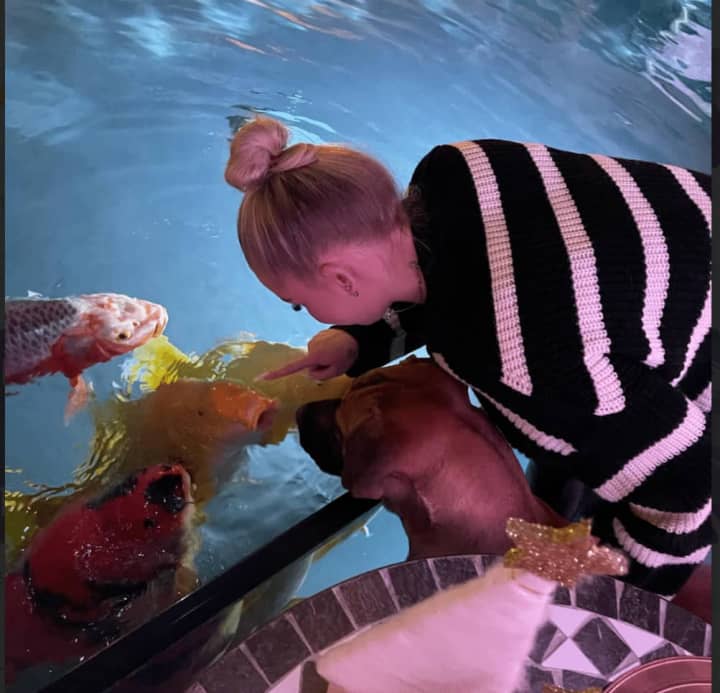
The filtration requirements for koi types must be taken into the account before the adoption of the koi varieties. Aquariums should be large enough for their potential fast growth and survival. For the younger koi species, 300 gallons of water will be enough but when they get older, bigger tanks will be required.
It is also imperative to install the high-quality filtering system because it can quickly remove the waste in small areas. Advanced filtration technologies, water changes and parameter monitoring are also necessary to prevent any damage. By controlling these factors, urban koi keepers can effectively retain the colours and can enjoy the beauty of these fish even in indoor spaces.
Monitoring the dissolved oxygen level in water, nitrite, nitrate, ammonia, and pH on the regular basis is crucial on the regular maintainance.Nitrite and ammonia are harmful to koi, so it is best to keep them at zero, while nitrate levels should be kept under 10ppm. The ideal pH range for koi is between 7.0 to 7.5.
In addition to keeping the water clear, a well-maintained filtration system promotes the biological activities required for a healthy koi environment. Mechanical filtration removes physical material, poisons, and impurities are removed by drum filter, filter brush ect. ), and harmful compounds are broken down by helpful bacteria group supported by biological filtration. For filtration effectiveness, regular maintenance of the filter system and filter media is also important.
A well-balanced diet is essential for the Koi’s healthy life. A nutritious diet should include the portions of commercial pellets. Commercial feed should include the all required minerals, vitamins and proteins.These pallets serve to meet the dietary requirements while also strengthening their immune system and promoting development and coloration.
Koi owners should give them feed according to their schedule in different seasons. As their metabolism increases during the warmer months(more than 20 degrees), then they should be fed once or twice a day. Avoid overfeeding, as it may have negative health effects with three times a day. And owner can adjust the volume as the water conditions change or weather changes.

The better survival of the koi depends on the early detection of the disease and regular preventive care. Koi has several illness-detection symptoms including behavioural changes, appetite loss, physical appearance, spots, lesions and unusual swimming patterns. Treatments can be possible if symptoms are identified in the early stage.
Disease risks can be decreased by providing a balanced diet, ideal water quality and implementing biosecurity measures. Preventive care involves essential measures such as regular pond maintenance, and suitable quarantine procedures for new fish.
Proper quarantine and treatment guidelines are necessary for the koi’s healthy lifestyle. Quarantine is placing the sick or new fish in a different tank for at least 2 to 4 weeks to keep the pond free from any disease. During the quarantine, close observation is feasible, identified and treated without harming other fish.
Treatments are based on the condition of the disease. Medications, salt and water treatments are used for the common diseases such as bacterial, fungal or parasite infections.
Overall, the variety and striking patterns found in each koi fish highlight the intriguing world of these fish. Each fish has unique qualities and a graceful appearance. These fish types are the greatest way to bring the multicoloured beauty to indoor and outdoor ponds. Their admiring aesthetics need basic care and maintenance, water quality, filtration, a balanced diet, and effective treatments are all necessary. By fulfilling all the requirements, every beginner can become expert enthusiastic in the field of koi fish.
What are the ideal water conditions for koi fish?
Ideal water conditions include well-oxygenated water, zero ammonia, a pH level of 7.0- 7.5, and a nitrite level around 0ppm, 20-25 degrees water temperature, a biochemical ability level of 5more level, excellent dissolved oxygen: 7-14 mg/liter.
How often should I clean and maintain my koi pond?
Partial water changes(20-30%) can be done every week. A full pond cleaning, which includes cleaning different filter chambers (step by step), is needed once a year.
What are the benefits of having a variety of koi fish in my pond?
Having a variety of koi fish species enhances the beauty of the pond, with different patterns, sizes, and colours creating an engaging environment. In that way, you can create an amazing pond view, especially in winter.
How do I winterize my koi pond to protect the fish during cold months?
In winter, clean the pond, use a de-icer or pond heater, and reduce the diet to protect the fish in cold months.You must also use an aerator to stabilise the oxygen level. Some hobbyists will use greenhouse to protect their outdoor koi pond. If you have space, you can also bring the koi into an indoor koi pond.
Leave a Reply